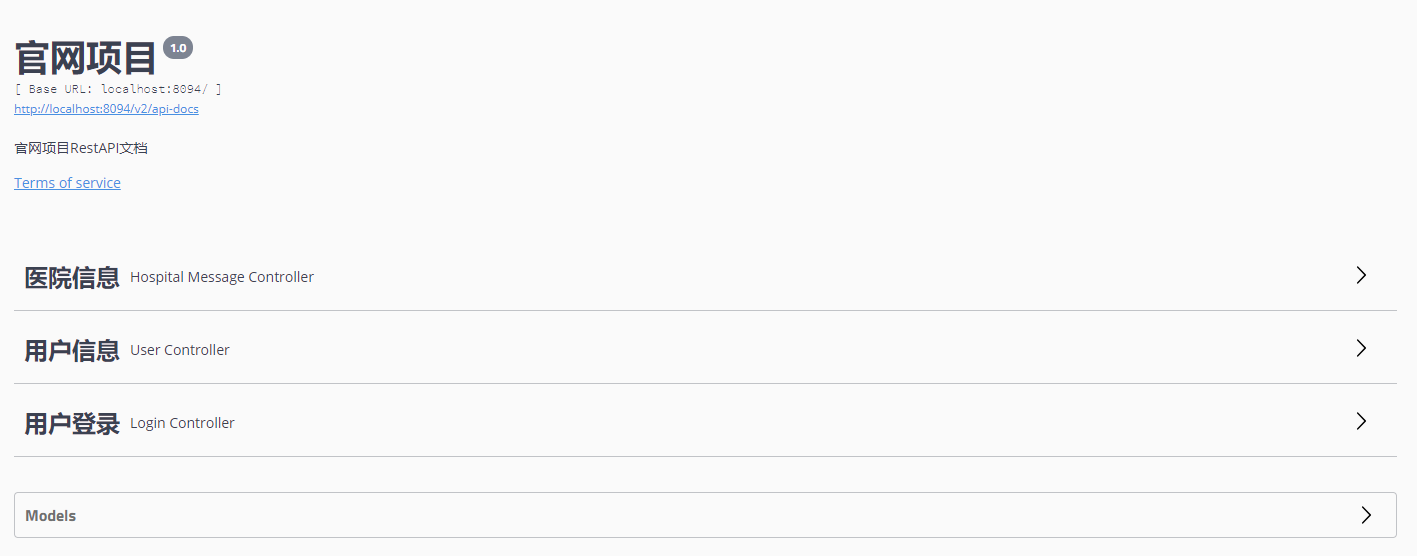何为Swagger
设计是API开发的基础。Swagger使API设计变得轻而易举,为开发人员,架构师和产品所有者提供了易于使用的工具。——官网
1)具有准确的API模型
API设计容易出错,在建模API时发现和纠正错误是非常困难和耗时的。Swagger Editor是第一个使用OpenAPI规范(OAS)设计API的编辑器,并且继续满足开发人员使用OAS构建API的需求。编辑器实时验证您的设计,检查OAS合规性,并随时提供视觉反馈。
2)在设计时可视化
最好的API是针对最终消费者而设计的。像Swagger编辑器和SwaggerHub这样的Swagger工具为YAML编辑器提供了一个可视化面板,供开发人员使用,并查看API对最终消费者的外观和行为。
3)在整个团队中标准化设计风格
提供共享通用行为,模式和一致的RESTful接口的API将极大地简化构建它们的人员和想要使用它们的消费者的工作。SwaggerHub配备了内置的API标准化工具,可以使您的API符合您的组织设计指南。
添加依赖
1、pom.xml:
在此添加如下依赖:
<dependency>
<groupId>com.spring4all</groupId>
<artifactId>spring-boot-starter-swagger</artifactId>
<version>1.5.1.RELEASE</version>
</dependency>
<dependency>
<groupId>io.springfox</groupId>
<artifactId>springfox-swagger-ui</artifactId>
<version>2.8.0</version>
</dependency>
<dependency>
<groupId>io.springfox</groupId>
<artifactId>springfox-swagger2</artifactId>
<version>2.8.0</version>
</dependency>
启动类
在Spring Boot项目启动类上添加@EnableSwagger2注解。
项目配置
在项目的.properties中添加:
#swagger开启关闭
swagger.enabled=true
类配置
import org.springframework.beans.factory.annotation.Value;
import org.springframework.context.annotation.Bean;
import org.springframework.context.annotation.Configuration;
import springfox.documentation.builders.ApiInfoBuilder;
import springfox.documentation.builders.PathSelectors;
import springfox.documentation.builders.RequestHandlerSelectors;
import springfox.documentation.service.ApiInfo;
import springfox.documentation.spi.DocumentationType;
import springfox.documentation.spring.web.plugins.Docket;
import springfox.documentation.swagger2.annotations.EnableSwagger2;
/**
* Swagger2 的配置注入
* @author ligj
*
*/
@Configuration
@EnableSwagger2
public class Swagger2Config {
@Value("${swagger.enable}")
private boolean enable;
@Bean
public Docket createRestApi() {
return new Docket(DocumentationType.SWAGGER_2).enable(enable)
.apiInfo(apiInfo())
.select()
.apis(RequestHandlerSelectors.basePackage("com.xxx.controller"))
.paths(PathSelectors.any())
.build();
}
private ApiInfo apiInfo() {
return new ApiInfoBuilder()
.title("你的title")
.description("xxx 项目RestAPI文档")
.termsOfServiceUrl("...")
.version("1.0")
.build();
}
}
拦截器
如果有设置拦截器,那么需要放行swagger。
@Override
public void addInterceptors(InterceptorRegistry registry) {
registry.addInterceptor(authenticationInterceptor())
.addPathPatterns("/**")
.excludePathPatterns("/swagger-resources/**", "/webjars/**","/v2/**", "/swagger-ui.html/**"); //放行swagger;
}
如果项目中没有拦截器,并且遇到了No mapping found for HTTP request with URI [/swagger-resources/configuration/ui] in DispatcherServlet with name 'dispatcherServlet',那么需要添加WebMvcConfigurerConfig:
package com.lamarsan.livelihood_background.config;
import org.springframework.context.annotation.Configuration;
import org.springframework.web.cors.CorsConfiguration;
import org.springframework.web.servlet.config.annotation.EnableWebMvc;
import org.springframework.web.servlet.config.annotation.ResourceHandlerRegistry;
import org.springframework.web.servlet.config.annotation.WebMvcConfigurer;
/**
* className: WebMvcConfigurerConfig
* description: TODO
*
* @author hasee
* @version 1.0
* @date 2019/8/12 10:02
*/
@Configuration
@EnableWebMvc
public class WebMvcConfigurerConfig implements WebMvcConfigurer {
private CorsConfiguration buildConfig() {
CorsConfiguration corsConfiguration = new CorsConfiguration();
corsConfiguration.addAllowedOrigin("*");
corsConfiguration.setAllowCredentials(true);
corsConfiguration.addAllowedHeader("*");
corsConfiguration.addAllowedMethod("*");
return corsConfiguration;
}
@Override
public void addResourceHandlers(ResourceHandlerRegistry registry) {
registry.addResourceHandler("swagger-ui.html")
.addResourceLocations("classpath:/META-INF/resources/");
registry.addResourceHandler("/webjars/**")
.addResourceLocations("classpath:/META-INF/resources/webjars/");
}
}
常用API
常用注解有:
1、Api
2、ApiModel
3、ApiModelProperty
4、ApiOperation
5、ApiParam
6、ApiResponse
7、ApiResponses
8、ResponseHeader
Api注解
Api用在类上,说明该类的作用,可以标记一个Controller类作为swagger文档资源,标记在类上,使用方式:
@Api(tags = "信息")
public class Controller{
...
}
属性配置
| 属性名称 | 备注 |
|---|---|
| value | url的路径值 |
| tags | 如果设置这个值,value的值会被覆盖 |
| description | 对api资源的描述 |
| basePath | 基本路径可以不配置 |
| position | 如果配置多个Api 想改变显示的顺序位置 |
| produces | For example, “application/json, application/xml” |
| consumes | For example, “application/json, application/xml” |
| protocols | Possible values: http, https, ws, wss. |
| authorizations | 高级特性认证时配置 |
| hidden | 配置为true 将在文档中隐藏 |
ApiOperation注解
用在方法上,说明方法的作用,每一个url资源的定义,使用方式:
@ApiOperation(value = "your describle")
@RequestMapping(value = "/xxx",method = RequestMethod.POST, produces = "application/json;charset=UTF-8")
public RestResponseModel getSongByUnit(@RequestBody @Validated UnitDTO unitDTO, @ApiIgnore ReqUser reqUser){
your code
}
如果项目中没有拦截器,并且遇到了No mapping found for HTTP request with URI [/swagger-resources/configuration/ui] in DispatcherServlet with name 'dispatcherServlet',那么需要添加WebMvcConfigurerConfig:
package com.lamarsan.livelihood_background.config;
import org.springframework.context.annotation.Configuration;
import org.springframework.web.cors.CorsConfiguration;
import org.springframework.web.servlet.config.annotation.EnableWebMvc;
import org.springframework.web.servlet.config.annotation.ResourceHandlerRegistry;
import org.springframework.web.servlet.config.annotation.WebMvcConfigurer;
/**
* className: WebMvcConfigurerConfig
* description: TODO
*
* @author hasee
* @version 1.0
* @date 2019/8/12 10:02
*/
@Configuration
@EnableWebMvc
public class WebMvcConfigurerConfig implements WebMvcConfigurer {
private CorsConfiguration buildConfig() {
CorsConfiguration corsConfiguration = new CorsConfiguration();
corsConfiguration.addAllowedOrigin("*");
corsConfiguration.setAllowCredentials(true);
corsConfiguration.addAllowedHeader("*");
corsConfiguration.addAllowedMethod("*");
return corsConfiguration;
}
@Override
public void addResourceHandlers(ResourceHandlerRegistry registry) {
registry.addResourceHandler("swagger-ui.html")
.addResourceLocations("classpath:/META-INF/resources/");
registry.addResourceHandler("/webjars/**")
.addResourceLocations("classpath:/META-INF/resources/webjars/");
}
}
属性配置
| 属性名称 | 备注 |
|---|---|
| value | url的路径值 |
| tags | 如果设置这个值、value的值会被覆盖 |
| description | 对api资源的描述 |
| basePath | 基本路径可以不配置 |
| position | 如果配置多个Api 想改变显示的顺序位置 |
| produces | For example, “application/json, application/xml” |
| consumes | For example, “application/json, application/xml” |
| protocols | Possible values: http, https, ws, wss. |
| authorizations | 高级特性认证时配置 |
| hidden | 配置为true 将在文档中隐藏 |
| response | 返回的对象 |
| responseContainer | 这些对象是有效的 “List”, “Set” or “Map”.,其他无效 |
| httpMethod | “GET”, “HEAD”, “POST”, “PUT”, “DELETE”, “OPTIONS” and “PATCH” |
| code | http的状态码 默认 200 |
| extensions | 扩展属性 |
ApiParam注解
ApiParam为请求属性,使用方式:
public ResponseEntity<User> createUser(@RequestBody @ApiParam(value = "Created user object", required = true) User user)
属性配置
| 属性名称 | 备注 |
|---|---|
| name | 属性名称 |
| value | 属性值 |
| defaultValue | 默认属性值 |
| allowableValues | 可以不配置 |
| required | 是否属性必填 |
| access | 不过多描述 |
| allowMultiple | 默认为false |
| hidden | 隐藏该属性 |
| example | 举例子 |
ApiModelProperty注解
描述一个model的属性,具体用法如下:
@ApiModelProperty(value = "your describle")
private String id;
swagger页面
运行springboot项目后,在浏览器中输入http://localhost:8080/swagger-ui.html#/,页面效果如图所示:






















 2984
2984

 被折叠的 条评论
为什么被折叠?
被折叠的 条评论
为什么被折叠?








